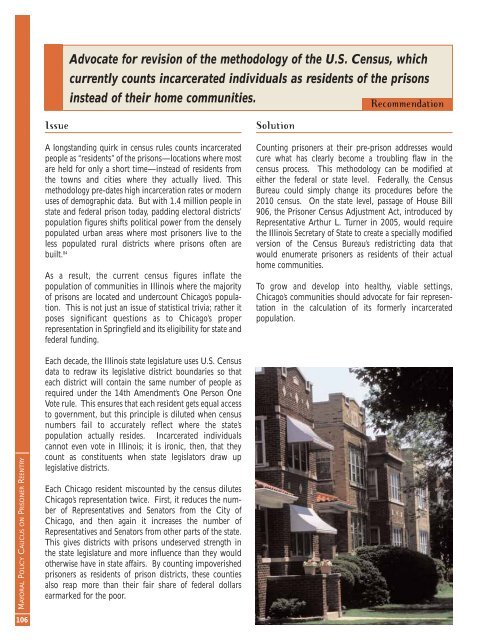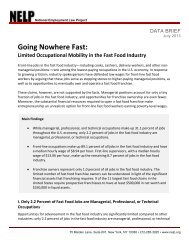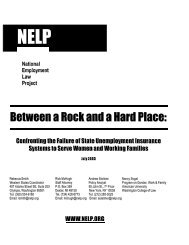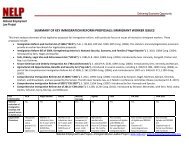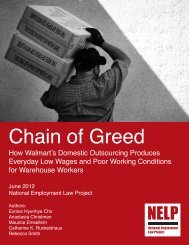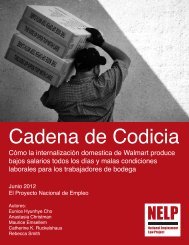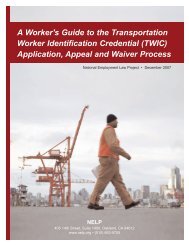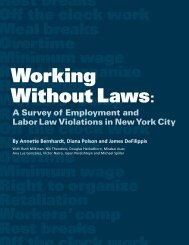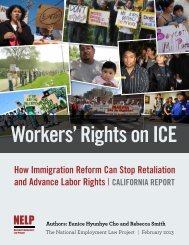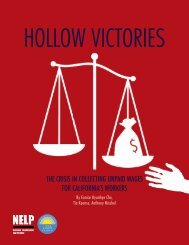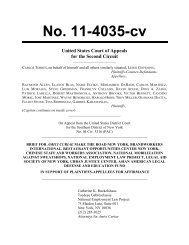Rebuilding Lives. Strengthening Communities.
Rebuilding Lives. Strengthening Communities.
Rebuilding Lives. Strengthening Communities.
Create successful ePaper yourself
Turn your PDF publications into a flip-book with our unique Google optimized e-Paper software.
Advocate for revision of the methodology of the U.S. Census, which<br />
currently counts incarcerated individuals as residents of the prisons<br />
instead of their home communities.<br />
Recommendation<br />
Issue<br />
A longstanding quirk in census rules counts incarcerated<br />
people as “residents” of the prisons—locations where most<br />
are held for only a short time—instead of residents from<br />
the towns and cities where they actually lived. This<br />
methodology pre-dates high incarceration rates or modern<br />
uses of demographic data. But with 1.4 million people in<br />
state and federal prison today, padding electoral districts’<br />
population figures shifts political power from the densely<br />
populated urban areas where most prisoners live to the<br />
less populated rural districts where prisons often are<br />
built. 84<br />
As a result, the current census figures inflate the<br />
population of communities in Illinois where the majority<br />
of prisons are located and undercount Chicago’s population.<br />
This is not just an issue of statistical trivia; rather it<br />
poses significant questions as to Chicago’s proper<br />
representation in Springfield and its eligibility for state and<br />
federal funding.<br />
Solution<br />
Counting prisoners at their pre-prison addresses would<br />
cure what has clearly become a troubling flaw in the<br />
census process. This methodology can be modified at<br />
either the federal or state level. Federally, the Census<br />
Bureau could simply change its procedures before the<br />
2010 census. On the state level, passage of House Bill<br />
906, the Prisoner Census Adjustment Act, introduced by<br />
Representative Arthur L. Turner in 2005, would require<br />
the Illinois Secretary of State to create a specially modified<br />
version of the Census Bureau’s redistricting data that<br />
would enumerate prisoners as residents of their actual<br />
home communities.<br />
To grow and develop into healthy, viable settings,<br />
Chicago’s communities should advocate for fair representation<br />
in the calculation of its formerly incarcerated<br />
population.<br />
MAYORAL POLICY CAUCUS ON PRISONER REENTRY<br />
Each decade, the Illinois state legislature uses U.S. Census<br />
data to redraw its legislative district boundaries so that<br />
each district will contain the same number of people as<br />
required under the 14th Amendment’s One Person One<br />
Vote rule. This ensures that each resident gets equal access<br />
to government, but this principle is diluted when census<br />
numbers fail to accurately reflect where the state’s<br />
population actually resides. Incarcerated individuals<br />
cannot even vote in Illinois; it is ironic, then, that they<br />
count as constituents when state legislators draw up<br />
legislative districts.<br />
Each Chicago resident miscounted by the census dilutes<br />
Chicago’s representation twice. First, it reduces the number<br />
of Representatives and Senators from the City of<br />
Chicago, and then again it increases the number of<br />
Representatives and Senators from other parts of the state.<br />
This gives districts with prisons undeserved strength in<br />
the state legislature and more influence than they would<br />
otherwise have in state affairs. By counting impoverished<br />
prisoners as residents of prison districts, these counties<br />
also reap more than their fair share of federal dollars<br />
earmarked for the poor.<br />
106


